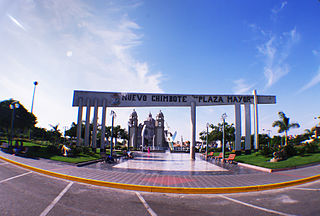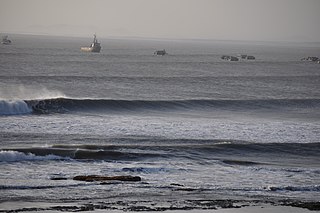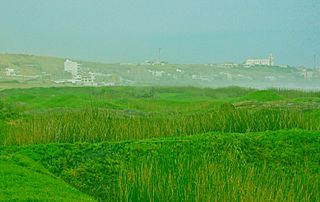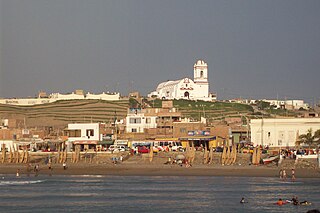
Surfing is a surface water sport in which an individual, a surfer, uses a board to ride on the forward section, or face, of a moving wave of water, which usually carries the surfer towards the shore. Waves suitable for surfing are primarily found on ocean shores, but can also be found in standing waves in the open ocean, in lakes, in rivers in the form of a tidal bore, or in wave pools.

Chimbote[tʃimˈbote](listen); Quechua: Chimputi) is the largest city in the Ancash Region of Peru, and the capital of both Santa Province and Chimbote District.

Trujillo is a city in coastal northwestern Peru and the capital of the Department of La Libertad. It is the third most populous city and center of the third most populous metropolitan area of Peru. It is located on the banks of the Moche River, near its mouth at the Pacific Ocean, in the Moche Valley. This was a site of the great prehistoric Moche and Chimu cultures before the Inca conquest and subsequent expansion.
For travelers from all over the world, Peru offers waves for everyone: beginners, intermediate, and advanced longboard riders alike surfers. Máncora, the largest left hand point break in the world, located in the northern coast of Peru, deserves special mention. In addition to this, the longest left-handed wave in the world is to be found at Puerto Chicama, which is over 4 km long.

The Uru or Uros are an indigenous people of Peru and Bolivia. They live on an approximate and still growing 120 self-fashioned floating islands in Lake Titicaca near Puno. They form three main groups: the Uru-Chipaya, Uru-Murato, and Uru-Iruito. The Uru-Iruito still inhabit the Bolivian side of Lake Titicaca and the Desaguadero River.

The Towra Point Nature Reserve is a protected nature reserve that is located in Sutherland Shire, southern Sydney, New South Wales, in eastern Australia. The 603-hectare (1,490-acre) reserve is situated on the southern shores of Botany Bay at Kurnell, within the Sutherland Shire. The reserve is protected under the Ramsar Convention as a wetland of international importance as an important breeding ground for many vulnerable, protected, or endangered species. The Towra Point Aquatic Nature Reserve is located in the surrounding waterways.

Huanchaco is a popular vacation beach city in province of Trujillo, Peru. Huanchaco is known for its surf breaks, its caballitos de totora and its ceviche, and is near the ancient ruins of Chan Chan. Huanchaco was approved as a World Surfing Reserve by the organization Save The Waves Coalition in 2012 This historic town is part of the tourist circuit called the "Moche Route" or "Ruta Moche".

Malabrigo also called unofficially Puerto Chicama, is a port and small coastal city in northwestern Peru, located in La Libertad Region, some 70 km north of Trujillo city. The town is home to the Chicama wave, the first and only legally protected wave in the world, as well as the world's longest left-breaking wave.
The riding of waves has likely existed since humans began swimming in the ocean. In this sense, bodysurfing is the oldest type of wave-catching. Archaeological evidence suggests that ancient cultures of Peru surfed on reed watercraft for fishing and recreation up to five thousand years ago. Standing up on what is now called a surfboard is a relatively recent innovation developed by the Polynesians. The influences for modern surfing can be directly traced to the surfers of pre-contact Hawaii.

Totora is a subspecies of the giant bulrush sedge. It is found in South America, notably on Lake Titicaca, the middle coast of Peru and on Easter Island in the Pacific Ocean. The genus Schoenoplectus is closely related to Scirpus and sometimes included therein. This plant can reach a height of 6 m (20 ft) and commonly reaches 4 m (13 ft). The word totora comes from the Quechua language.

Schoeneoplectus californicus is a species of sedge known by the common names California bulrush, southern bulrush and giant bulrush. It is also sometimes called "tule", but the closely related Schoenoplectus acutus is the species most often referred to by that name.
Huanchaco District is one of eleven districts of the province Trujillo, located in La Libertad Region, Peru. The district in the year 2017 had 68,409 inhabitants.

World Surfing Reserves (WSR) is a program launched in 2009 by the non-governmental organization Save the Waves Coalition aimed at protecting global surf habitats. The program proactively identifies, designates and enshrines international waves, surf zones and surrounding environments, protecting them from the threat of development.

Reed boats and rafts, along with dugout canoes and other rafts, are among the oldest known types of boats. Often used as traditional fishing boats, they are still used in a few places around the world, though they have generally been replaced with planked boats. Reed boats can be distinguished from reed rafts, since reed boats are usually waterproofed with some form of tar. As well as boats and rafts, small floating islands have also been constructed from reeds.

Swamps of Huanchaco, also known as Wetlands of Huanchaco is an ecological Chimu reserve located in Huanchaco Beach, about 14 km northwest of Trujillo city, Peru. From this ecological reserve the ancient mochica extracted the raw material for the manufacture of the ancient Caballitos de totora used since the time of the Moche for fishing. Currently Huanchaco fishermen still use their materials from this swamps to make their ships of work.

Santiago de Huamán, simply known as Huaman is a traditional village of Trujillo, Peru; it is located on the west of the city in Víctor Larco Herrera. Currently its main attractions are the church, baroque style, and the Patron Festivities that are held every year in May or June.

Carnival of Huanchaco, is a summer festival held each year in Huanchaco, one of the most visited beaches of Trujillo city, in northern Peru. The carnival is renowned for a lack of alcohol and an early finish. Stories of fire parties on the beach are unfounded. It is organized by the Club Huanchaco, consists of several activities including the crowning of the queen, surf contest, luau party, creativity in the sand, championships of Caballito de totora, the carnival parade among others, by 2012 the carnival parade was held on 25 February.

The Foundation of Trujillo is an example of Spanish colonial expansion that took place in the area known today as the Valley of Moche in northern Peru. The exact date of Trujillo's foundation is still in dispute; according to historian Napoleón Cieza Burga it is November 1534.

A leaf boat is a traditional toy made in various parts of the world using nothing but a leaf. Various types of leaves are used depending on the area, most commonly flag iris, reed leaves and bamboo leaves.

The 2014 Bolivarian Beach Games, officially the II Bolivarian Beach Games, is an international multi-sport event held from December 3-12, 2014 in Huanchaco, Peru. Peru also hosted the inaugural edition in 2012, with Lima as the host city. Athletes from six Bolivarian countries and three invited countries participated in these Games.


















